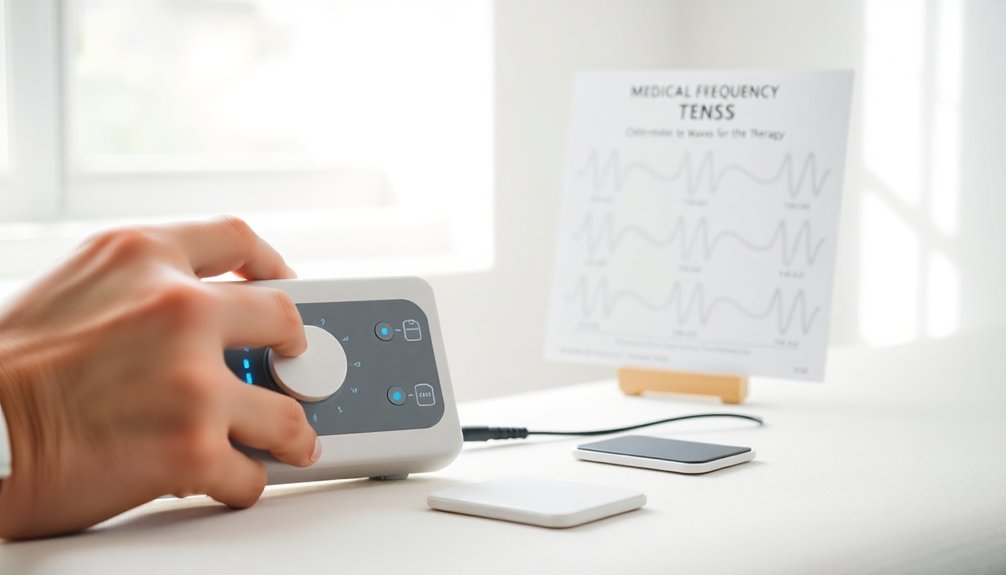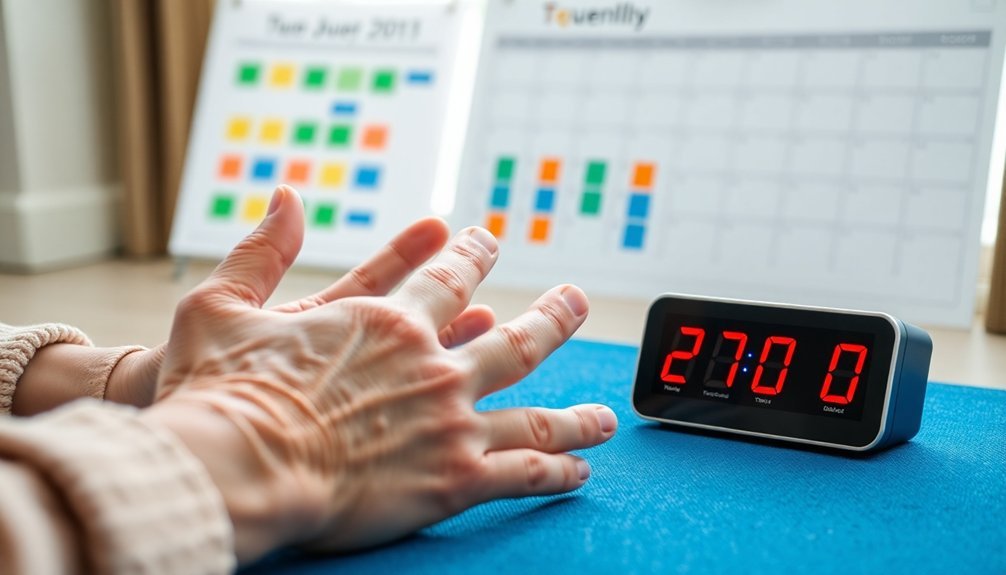You'll get the best joint pain relief by focusing on three key frequency-based approaches. First, use TENS therapy at 2-5 Hz for chronic pain, applying it for 15-30 minutes per session over a two-week period. Second, incorporate light therapy with wavelengths between 800-850 nm, which effectively penetrates deep into joints and tissues. Third, maintain a consistent treatment schedule of 18-24 sessions to build cumulative healing benefits. When you combine these three frequency treatments with the right settings and timing, you'll access more powerful ways to manage your joint pain effectively.
Optimal Frequency Treatment Settings

Selecting the right treatment frequency acts as a cornerstone for effective joint pain management. When using TENS therapy, you'll find that both 2 Hz and 100 Hz settings prove effective for osteoarthritic knee pain. You can also opt for alternating frequencies between 2 Hz and 100 Hz, as this approach shows similar pain-reducing benefits.
For the best results with TENS therapy, you'll want to maintain a consistent schedule of 30-minute sessions, five days per week, for at least two weeks. This structured approach helps guarantee you're getting the maximum therapeutic benefit from your treatment.
If you're incorporating cold laser or LED light therapy into your routine, you'll need to adjust the frequency based on your pain type. For acute pain, schedule sessions 2-3 times weekly, while chronic pain may require a more customized approach. Manual therapy techniques can complement these treatments by improving joint alignment and reducing stiffness.
Work closely with your healthcare provider to determine the ideal treatment intervals for your specific condition. They'll help you develop a schedule that starts more intensively and gradually reduces frequency as your healing progresses.
Remember that these guidelines serve as a starting point, and you may need to modify them based on your body's response to treatment.
Wavelength Selection For Pain Relief
When targeting joint pain with light therapy, understanding wavelength selection becomes crucial for best results. You'll want to focus on wavelengths between 800-850 nm, with 850 nm being the most effective for deep joint pain relief.
While shorter wavelengths like 660 nm can be beneficial for surface-level treatments, they won't penetrate deeply enough to address joint issues effectively. Consistent treatment over 2-4 weeks typically yields the most noticeable improvements in joint pain.
For effective joint pain relief, you'll need near-infrared light, which penetrates deeper into your tissues than visible red light. The 800-880 nm range is particularly effective for accessing deep-seated pain and promoting healing in joints and muscles.
If you're dealing with chronic joint issues, consider devices that offer multiple wavelengths, as this approach can provide more extensive therapeutic benefits.
When selecting your light therapy device, make sure to check its wavelength specifications carefully. While wavelengths between 630-850 nm can be therapeutic, you'll get the best results for joint pain using devices that operate in the higher ranges.
Don't hesitate to consult with a healthcare professional to determine which wavelength combination will work best for your specific condition.
Treatment Time And Consistency

To get the most out of light therapy for joint pain, you'll need to stick to a consistent treatment plan spanning 18 to 24 sessions. Each session builds upon the previous one, creating a cumulative effect that maximizes your healing potential. Think of it like building muscle – you won't see lasting results from just a few workouts. Most patients experience positive initial changes within their first few treatments.
| Treatment Aspect | Impact of Consistency |
|---|---|
| Healing Process | Progressive improvement with each session, reducing risk of relapse |
| Recovery Time | Faster recovery through regular, structured sessions |
| Long-term Results | Sustained pain relief and improved joint mobility |
| Prevention | Reduced risk of future injuries and setbacks |
Don't be tempted to stop treatment early when you start feeling better. Completing your full course of therapy guarantees long-term stability and prevents relapses. Your treatment plan will be customized to your specific needs, with adjustments made based on your progress. You'll experience both physical and psychological benefits, including improved confidence and enhanced physical performance. By maintaining consistency in your therapy sessions, you're not just addressing current pain – you're investing in your long-term joint health and overall well-being.
Frequently Asked Questions
Can I Combine Frequency Therapy With Traditional Pain Medications?
Yes, you can combine frequency therapy with traditional pain medications. You'll need careful monitoring and proper dosing though, as combination therapies may increase risk of side effects. Consult your healthcare provider first.
What Should I Do if Frequency Therapy Increases My Joint Pain?
Stop the therapy immediately if your joint pain worsens. You should consult your doctor right away, and they'll help determine why it's happening. Consider switching to alternative treatments like physical therapy or medications.
Are There Any Age Restrictions for Receiving Frequency-Based Joint Treatments?
You won't face specific age restrictions for frequency-based joint treatments. They're generally safe for all ages, but you'll need to inform your provider about any health conditions or concerns before starting treatment.
How Soon Can I Resume Physical Activities After Frequency Therapy Sessions?
You can resume light activities immediately after frequency therapy, but should wait 24 hours before strenuous exercise. Listen to your body and gradually increase activity based on your pain tolerance.
Does Health Insurance Typically Cover Frequency-Based Treatments for Joint Pain?
Your insurance coverage for frequency-based joint pain treatments varies by plan. While many commercial plans cover these therapies, you'll need to verify specific coverage limits and requirements with your insurance provider.
In Summary
You'll get the most benefit from joint pain therapy by following these three key guidelines. Maintain the recommended frequency settings for your specific condition, choose appropriate wavelengths backed by clinical research, and stick to a consistent treatment schedule. When you're diligent about these aspects of your therapy routine, you'll experience better pain relief and improved joint mobility over time.





Leave a Reply